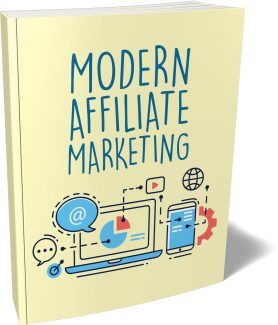 License Type: Master Resell Rights
License Type: Master Resell Rights  File Type: ZIP
File Type: ZIP
 SKU: 62029
SKU: 62029  Shipping: Online Download
Shipping: Online Download
Sample Content Preview
If you're getting into this training, you should already know how affiliate marketing works.
I'm happy to report that the mechanics of affiliate marketing have not changed. It’s roughly the same as it was when Amazon first launched in the mid-90's and pretty much pioneered the affiliate marketing game.
Today, the same model works. What has changed, however, are strategies that enable you to become a successful affiliate marketer. You have to use modern affiliate marketing strategies.
Strategies change based on changes in traffic sources as well as changes in conversion strategies. This training teaches you critical affiliate marketing strategies involving the following key decisions:
- How to pick the right affiliate programs
- How to create niche-focused conversion systems
- How to drive traffic to your conversion system
- How to fine tune and scale up your system
The videos that follow will step you through these key decisions.
Make no mistake, if you want to succeed with your affiliate marketing business, you have to focus on ROI. If you have a fuzzy idea of what return on investment means, you're playing the game wrong.
Picking the Right Affiliate Program to Promote all Boils Down to ROI
You have to pay attention to two components of ROI. The first component is very obvious. This is return on investment. Put simply, how do you get the most return for every dollar you spend on your business.
Return on effort (ROE) simply means getting as much money from an activity while putting in as little time and effort into it. Put it another way, how do I maximize my income while minimizing my effort? For
every minute I spend on doing something, how do I maximize the amount of dollars coming out of that activity?
Both these factors must be at play. You always have to constantly filter all your affiliate marketing decisions through these principles. Otherwise, you're not going to make much money in this game.
The Answer? Put a Heavy Focus on the Commercial Value of Your Niche
How do you make sure that you're always hitting ROE and ROI targets? Very simple. To maximize your ROI and ROE, you need to pick the right niche first, then pick the right affiliate program.
A lot of people get the order wrong. They often build their whole business around an affiliate program when it turns out that the niche they're targeting is simply too hard, too saturated or too fragmented for them to turn a steady profit.
Follow the steps below and you will be well on your way to maximizing ROI and ROE. Spend less time, make more money.
The Niche Selection Process
Step #1: Identify your personal interests
Off the top of your head, list down all the topics and themes you are personally passionate about.
Ask yourself, "If I wasn't getting paid anything, what would I talk about?" You need to do this because you don't want to hit a point where you lose passion. You can't run on fumes.
Step #2: Use Google's Keyword Planner tool to find the commercial value of keywords related to your niche
Enter your topics into Google AdWords’ Keyword Planner tool. This tool will tell you the average cost per click of keywords related to those topics. Don't pick niches that are very, very expensive, nor should you pick niches that are very, very cheap. Pick something in the middle.
You want to pick a commercially attractive niche to make sure there's enough affiliate programs that cater to that niche. But, you're picking the middle of the road because you don't want extreme competition and saturation on one end, and little to no demand on the other end.
Step #3: Use Google Keyword Planner tool (GKPT) to find search volume
GKPT will tell you the rough monthly search volume for keywords related to your niches. Again, just like with the previous step, pick something in the middle. Not too much traffic, not too little either.
When you pick niches that have very high levels of demand, you might have too much competition. On the other hand, if it doesn't have enough demand, then it may not be worth pursuing because you're not going to make that much money.
Step #4: Use Google Search to find competition level
At this point, enter all the keywords related to niches that remain on your list into Google's main search box. Your searches will return a list of websites targeting the keyword you searched for.
Cross off your list niches that have too much competition. This is comparative so take off the top 20-30% in terms of competition. Avoid targeting saturated niches. You don't want to build a website and put in all that time and effort only to find out that there's too much competition.
Step #5: Check keywords on social media platforms to determine coverage
Enter your remaining niches’ keywords onto social media platforms and look if there are enough Facebook groups, Twitter accounts, hashtags, and other indications of social media interest.
Pick niches that already have a decent amount of interest on social media because you would want to build your website or promote your affiliate links on areas on social media that are dedicated to your niche.
Step #6: Check Google Trends to make sure your niche is stable or growing in demand
This is crucial. You don't want to build your online empire on a niche that is on its way out. Use Google Trends and enter your search terms for your niches.
Do you see the arrow going up or going slightly up over time? Or do you see it flat lining or even dipping downward? If you see a flat line or if you see it decreasing in popularity over time, scratch that niche off your list.
Focus only on niches that are picking up popularity over a longer period of time, you can at least give yourself some market stability.
The first thing that you need to do is to understand different monetization methods. I've already described how an affiliate program works in the introduction of this training. However, different affiliate offers convert in different ways.
Pay Per Click:
The words of your content trigger PPC contextual ad systems to show ads that target those words.
Native ads are not contextual. Instead, they use pictures that look like article thumbnails. When people click on the native ad, you get paid.
Pay Per Sale (PPS):
When somebody clicks on your PPS, which is either tied to text or to graphics, they have to buy something for you to earn a commission.
Pay Per Action (CPA)
Pay per action offers to pay you money when people click on your link to see some sort of form. When they fill out the form, you earn money. Pretty straightforward, right?
CPA involves less ‘friction’ to the user. Oftentimes, people just need to enter their email address for you to make $0.20 to up to a dollar. Not too bad.
Merchandise Affiliate Programs
Merchandise affiliate programs are affiliate programs that sell physical products. When people see ads on your website, you won't get paid when people click the ads. You only get paid a commission when your visitors actually buy products.
How to Select Affiliate Programs
Ask yourself the following factors when picking one particular affiliate program over another.
Is the offer directly or closely related to your niche?
Look at a program’s offers, not necessarily the program itself. There are many programs that actually cater to many different niches. You have to look through their offers to see if there is something that tightly fits your niche.
Is the offer already heavily promoted?
Do a search for the name of the offer or the name of the company. Avoid saturated offers.
How easy is the conversion point of the offer?
Ideally, you should look for an offer that only requires a click for you to get paid. If that's not happening, look for offers that pay you for every email or zip code entered into a form. If that isn't available, then look at offers that pay you per sale at a very high percentage.
How flexible is the program in terms of advertising?
Does the program require you to use their own materials? Or are they okay with you coming up with your own materials? Can you use incentives? You don’t want to rack up tons of commissions only to get banned without getting paid.
Do they offer flexible landing pages?
Does the program allow you to come up with your own landing pages or do they have their own? If they have their own, are there many different versions? Be clear about how the sponsor is going to be converting your traffic.
- License: Master Resell Rights
- Category:Ebooks
- Tags:2018 Ebooks Master Resale Rights








